Suppose a solid extends from ![]() to
to ![]() . Suppose that when it is
cut by planes perpendicular to the x-axis, the cross-section of the
solid cut by such a plane has area
. Suppose that when it is
cut by planes perpendicular to the x-axis, the cross-section of the
solid cut by such a plane has area ![]() . As usual, I divide the interval from a to b into
subintervals of width
. As usual, I divide the interval from a to b into
subintervals of width ![]() (say
(say ![]() for some n).
for some n).
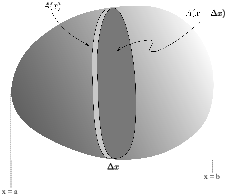
On a typical subinterval, I have cross-sections of areas ![]() and
and ![]() . It's
reasonable to suppose that if the function
. It's
reasonable to suppose that if the function ![]() is "nice enough", there should be a number
is "nice enough", there should be a number
![]() between x and
between x and ![]() such that the volume of the small
cross-section (or "slice") of thickness
such that the volume of the small
cross-section (or "slice") of thickness ![]() from x to
from x to ![]() is exactly
is exactly
![]()
Adding up the volumes of such cross-sections gives the volume of the solid:
![]()
Replacing ![]() with
with ![]() only gives an approximation:
only gives an approximation:
![]()
But if I take the limit as ![]() , then if
, then if
![]() is "nice enough" (for example,
continuous as a function of x), then in the limit I will get the
exact volume. It will be given by
is "nice enough" (for example,
continuous as a function of x), then in the limit I will get the
exact volume. It will be given by
![]()
Example. The cross-sections of a solid in planes perpendicular to the x-axis have area
![]()
Find the volume of the solid from ![]() to
to ![]() .
.
Since the cross-sectional area function is given, I just integrate from 0 to 1:
![]()
In the problems that follow, you need to determine the cross-sectional area function. In many cases, it comes from an area formula from geometry. Here are some common ones.
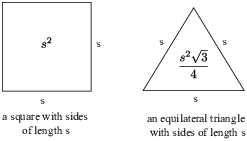
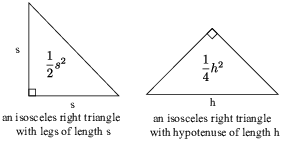
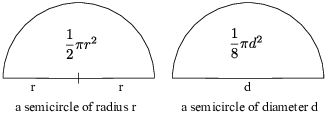
Example. The base of a solid is the region in
the x-y plane bounded above by ![]() and below by the x-axis, from
and below by the x-axis, from ![]() to
to ![]() . The cross-sections in planes
perpendicular to the x-axis are squares with one side lying in the
x-y plane. Find the volume of the solid.
. The cross-sections in planes
perpendicular to the x-axis are squares with one side lying in the
x-y plane. Find the volume of the solid.

![]()
Example. The base of a solid is the region in
the x-y plane bounded above by ![]() and below by the x-axis. The cross-sections
in planes perpendicular to the x-axis are equilateral triangles with
one side lying in the x-y plane. Find the volume of the solid.
and below by the x-axis. The cross-sections
in planes perpendicular to the x-axis are equilateral triangles with
one side lying in the x-y plane. Find the volume of the solid.
The base is bounded by ![]() and the
x-axis. The parabola intersects the x-axis at
and the
x-axis. The parabola intersects the x-axis at ![]() and
and ![]() .
.
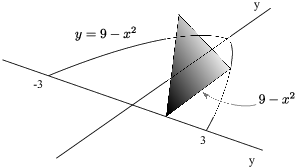
The picture shows a typical cross-section. It's an equilateral
triangle, and its side has length ![]() . Hence, the area of the cross-section is
. Hence, the area of the cross-section is
![]() .
.
The volume is
![]()
![]()
Example. The base of a solid is the region in
the first quadrant cut off by the line ![]() . The cross-sections in planes
perpendicular to the x-axis are semicircles with their diameters
lying in the x-y plane. Find the volume of the solid.
. The cross-sections in planes
perpendicular to the x-axis are semicircles with their diameters
lying in the x-y plane. Find the volume of the solid.
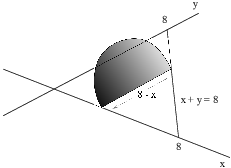
The diameter of a typical cross-section is ![]() , so the radius is
, so the radius is ![]() . The volume is
. The volume is
![]()
Example. The base of a solid is the region in
the first quadrant cut off by the line ![]() . The cross-sections in planes
perpendicular to the x-axis are isosceles right triangles with the
hypotenuses lying in the x-y plane. Find the volume of the solid.
. The cross-sections in planes
perpendicular to the x-axis are isosceles right triangles with the
hypotenuses lying in the x-y plane. Find the volume of the solid.
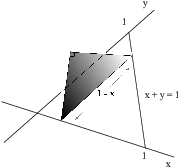
Since the hypotenuse of a typical triangle is ![]() , the side of such a triangle is
, the side of such a triangle is ![]() . The area of a triangular slice
is one-half the base times the height, which is
. The area of a triangular slice
is one-half the base times the height, which is
![]()
The volume is
![]()
Example. A solid hemisphere of radius 4 has its base in the x-y-plane. It is cut by a plane parallel to the x-y-plane and 1 unit above it. Find the volume of the part of the hemisphere which lies between the cutting plane and the x-y-plane.
In this problem, you have to decide how to slice the solid in order to give cross-sections whose areas you can compute. Slicing the solid by planes parallel to the x-y plane produces circular disks.

The next picture shows the solid in cross-section, with a typical slice drawn.
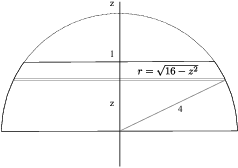
By Pythagoras' theorem, the radius of a disk lying z units above the
x-y-plane is ![]() , so its
cross-sectional area is
, so its
cross-sectional area is ![]() .
.
The volume is
![]()
Copyright 2019 by Bruce Ikenaga